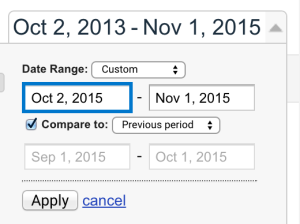If you’re wondering how to measure the effectiveness of your web marketing efforts, then look no further than Google Analytics!
Google Analytics is a free tool you can use to measure your website’s traffic & web marketing efforts.
If you have Google Analytics set up on your website , but aren’t using it, keep reading; as a wise man once said:
“you can’t improve what you don’t measure”
In today’s Marketing Minute we’re going to cover how to use the reports found under the Acquisition section of Google Analytics. This is the first in a series of three articles on how to use the reports found in Google Analytics.
Are my web marketing results improving over time?
You’re likely spending a great deal of resources marketing your business online – when you add up the cost of your website and time spent on social media and email newsletters, it’s mind boggling to think that the vast majority of business owners do not measure their efforts for effectiveness.
Once you’re logged in, set the date range up on the top right hand side to compare your results to last month. This way you can get a good idea if your results are improving over time.

Where is my website traffic coming from?
Once you’re signed in, on the left hand side click on Acquisition and then, Overview.
From there you’ll see a pie graph, which will show you the different sources of your website’s traffic:
 Ideally, this is going to be diversified, showing traffic from:
Ideally, this is going to be diversified, showing traffic from:
- ‘search’, which is search engines like Google,
- ‘direct’ – people typing in your website name directly,
- ‘referral’ – websites that are sending traffic to you,
- ‘social’ – your social media sites, and
- ‘e-mail’ – from your e-mail newsletter.
What websites are sending traffic to my website?
From Overview, then click on Referrals.
This is particularly useful if you have a domain name set-up for a particular campaign that is forwarded to your website or if you’re paying for any directory sites like bigyellowbookcompany.ca.
Here’s where you can see if you’re getting enough traffic to justify paying for any additional marketing efforts. You can see by how much traffic you’re getting as well as how engaged those people are that are coming from those particular websites.
How engaged are my website visitors?
Engagement can be measured by
- Session Duration shows the time that people are spending on your website when they come from that particular site
- Pages/Session shows the number pages that they’re looking at.
- Bounce Rate is also something to keep an eye on as well. That’s the amount of people that come to your website and leave right away. Ideally, this will be as low as possible.
How effective is my social media at sending traffic to my website?
Once you’ve taken a look at that report, the next thing I want you to do is go to Social and then Landing pages. This is fantastic.
This report will show you what pages and how they’re performing as it relates to traffic from social media websites.
So if you’re writing a blog post a week, (like I recommend that you do), you can see what blog posts are performing well and which ones aren’t.
Again, you can look at
- how much time people are spending on your website on each of these specific pages
- and how many pages are they looking at after they land on that particular page.
 Again, if you’re promoting a particular page, say, using Google Adwords, or promoting a specific page by posting your blog posts to social networks, you can see what pages are working and which ones aren’t.
Again, if you’re promoting a particular page, say, using Google Adwords, or promoting a specific page by posting your blog posts to social networks, you can see what pages are working and which ones aren’t.
Don’t be afraid to change & tweak your website pages & their headlines to increase your engagement and your performance of your website.
If you found this valuable, please share and/or comment. Thank you so much for watching!











